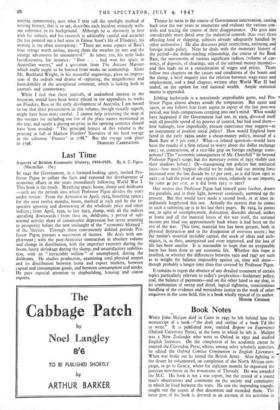Last Time
Aspects of British Economic History, 1918-1925. By A. C. Pigou. (Macmillan. 15s.) IN 1941 the Government, in a forward-looking spirit, invited Pro- fessor Pigou to collate the facts and expound the development of economic affairs in the years immediately following World War I. This book is the result. Breathing space, boom, slump and doldrums —such are the periods into which Professor Pigou divides the years under review. From the Armistice to April, 1919, breathing space ; for the next twelve months, boom, marked at each end by the re- spective upswing and downswing of the wholesale price and other indices ; from April, 192o, to late 1923, slump, with all the indices spiralling downwards ; from then on, doldrums, a period of sub- normal activity short of catastrophic depression but never attaining to prosperity before the new onslaught of the " economic blizzard " of the 'thirties. Through these conveniently defined periods Pro- fessor Pigou pursues a succession of themes. He deals with em- ployment ; with the post-Armistice 'contraction in absolute volume and change in distribution, with the imperfect recovery during the boom, heavy shrinkage during the slump, and unsatisfactory stabilisa- tion, with an " intractable million " of unemployed, during the doldrums. He studies production, examining total physical output and its distribution between home and export markets, between capital and consumption goods, and between consumption and stocks. He pays especial attention to shipbuilding, housing and cotton exports.
Thence he turns to the course of Government intervention, casting back over the war years to enumerate and evaluate the various con- trols and tracing the course of their disappearance. (He goes into considerably more detail over the industrial controls than over those affecting food or shipping, subjects already adequately handled by other authorities.) He also discusses price restrictions, rationing and foreign trade policy. Next he deals with the monetary history of the period—the dollar-sterling relationship, the course of the Bank Rate, the movements of various significant indices (volume of cur- rency, of deposits, of clearings, size of the national money ificome)— and this leads on to a consideration of wages and prices. There follow two chapters on the causes and conditions of the boom and the slump, a brief enquiry into the relation between wage-rates and employment, and a final chapter, written after World War II had ended, on the upshot for real national wealth. Ample statistical matter is appended.
Jobbing backwards is a notoriously unprofitable game, and Pro- fessor Pigou almost always avoids the temptation. But again and again, as one follows him from aspect to aspect of the last post-war period, one finds comparisons creeping into one's mind. What would have happened if the Government had not, in r9t9,' divested itself with all possible speed of its powers of control, but had used them— how haltingly, how imperfectly, present experience may suggest—as an instrument of positive social policy? How would England have fared in the early 19205 under a cheap-money policy, instead of a Bank Rate of 7 per cent.? What—a related question—would have been the results of a firm refusal to worry about the dollar exchange rate ; or, contrariwise, of a vice-like grip on foreign exchange trans- actions? (The " economic consequences of Mr. Churchill " li'e beyond Professor Pigou's scope, but the monetary events of 1925 visibly cast their shadows before.) Or—transposing not policies but statistical facts—how much happier should we be today had our mining force increased over the last decade by 17 per cent., as it did from 1911 to 1921 ; or had the price of our exports risen, relatively to our imports, by some 4o per cent. as it did from 1913 to 1921?
One wishes that Professor Pigou had himself gone further, drawn the parallels, and in their light, however cautiously, summed up the present. But that would have made a second book, or at least in- ordinately lengthened this one. Actually the nearest that he comes to such a summing up is in his last three pages. By 1924, he points out, in spite of unemployment, dislocation, disorder abroad, strikes at home and all the material losses of the war itself, the national income per head was approximately back where it had been on the eve of the war. This time, material loss has been greater, both in physical destruction and in the dissipation of overseas assets ; but the nation's essential invisible capital, the stock of ideas and tech- niques, is, as then, unimpaired and even improved, and the loss of life has been 'smaller. It is reasonable to hope that no irreparable harm has been done to our economic life. Whether this hope is justified, or whether the differences between 1920 and 1947 are such as to weight the balance impossibly against us, time will show— though probably a longer time than that covered by Professor Pigou.
It remains to regret the absence of any detailed treatment of certain topics particularly relevant to today's perplexities—budgetary policy, coal, the balance of payments—and on the other hand to say that, in its combination of sweep and detail, logical tightness, conscientious handling of the evidence and meticulous justice to the work of other enquirers in the same field, this is a book wholly typical of its author.
HONOR CROOME.






































 Previous page
Previous page